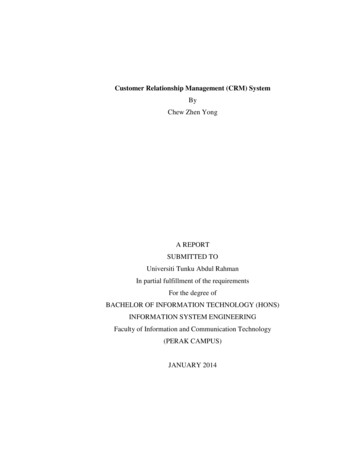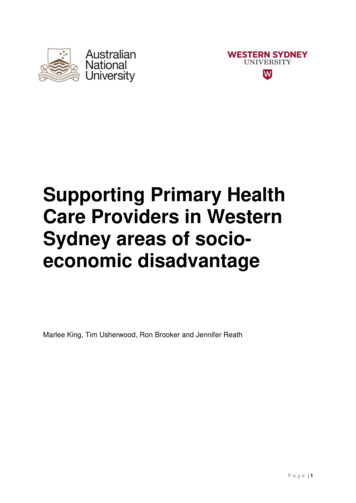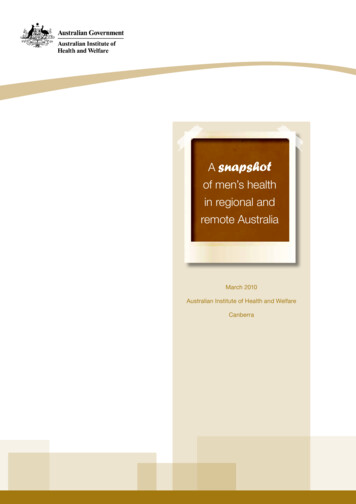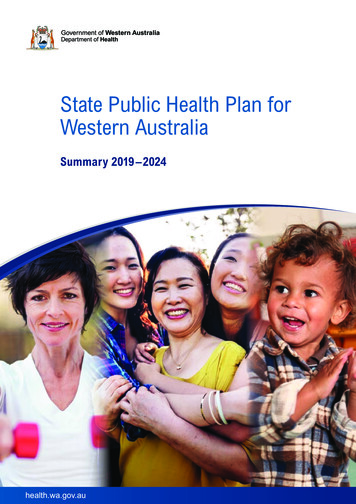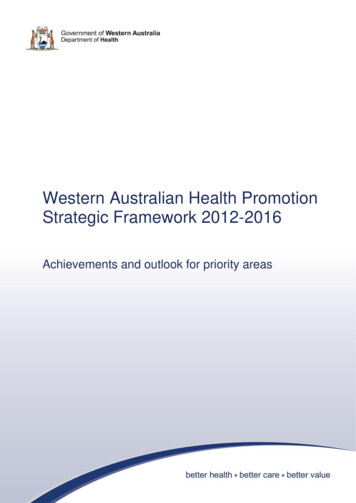
Transcription
Western Australian Health PromotionStrategic Framework 2012-2016Achievements and outlook for priority areas
WA Department of Health 2017Copyright to this material is vested in the State of Western Australia unless otherwiseindicated. Apart from any fair dealing for the purposes of private study, research, criticism orreview, as permitted under the provisions of the Copyright Act 1968, no part may bereproduced or re-used for any purposes whatsoever without written permission of the Stateof Western Australia.Suggested citationChronic Disease Prevention Directorate. Western Australian Health Promotion StrategicFramework 2012–2016: achievements and outlook for priority areas. Perth: Department ofHealth, Western Australia; 2017.Important disclaimerAll information and content in this material is provided in good faith by the Department ofHealth, Western Australia, and is based on sources believed to be reliable and accurate atthe time of development. The State of Western Australia, the Department of Health, WesternAustralia and their respective officers, employees and agents, do not accept legal liability orresponsibility for the material, or any consequences arising from its use.
ContentsIntroduction . 2Eating for Better Health . 3A More Active WA . 7Maintaining a Healthy Weight . 11Making Smoking History. 15Reducing Harmful Alcohol Use . 19Creating Safer Communities . 23Concluding comments and looking ahead to the next five years . 27References . 28Department of Health WA’s key partners in health promotion . 301
IntroductionEach year, tens of thousands of Australians die prematurely as a result of chronicdisease and injury.1Around 90 per cent of deaths in Australia are the result of chronic disease, and it isestimated that one in five of these deaths could potentially be avoided throughprimary prevention, screening or appropriate treatment.1In 2011, tobacco use (9%), dietary factors (7%), high body mass (6%), alcohol use(5%) and physical inactivity (5%) all made substantial contributions as risk factors tothe number of years of healthy life lost in Australia.2In WA alone, chronic diseases linked to these risk factors are responsible for almost200,000 hospitalisations and 5,000 deaths a year.3 Between 2009 and 2013, theassociated hospital costs for chronic diseases were more than 3.4 billion4 (notingthat hospital costs are only one small part of the overall cost of chronic disease).In addition, injuries lead to around 200,000 emergency department presentations,50,000 hospitalisations and 1,000 deaths each year in WA.5 Between 2009 and2013, hospital costs for injury alone were more than 1.6 billion.4In response to the sizeable impact of chronic disease and injury to the overall healthand wellbeing of the WA population, the Department of Health WA (‘theDepartment’), in partnership with other government and non-government agencies,invests considerable resources in prevention efforts that aim to lower the incidenceand impact of chronic disease and injury in WA.These efforts are guided by the Department’s WA Health Promotion StrategicFramework 2012-16 (the Framework), a five-year plan for health promotionpriorities for the state. Over 2012–2016 the Department has focused on six priorityareas: Eating for better healthA more active WAMaintaining a healthy weightMaking smoking historyReducing harmful alcohol useCreating safer communitiesThis short report presents some of the key achievements and activities of theDepartment and its many important partners working to prevent chronic disease andinjury in WA.2
Eating for Better HealthMaintaining a nutritious, balanced diet is vital for health and wellbeing and playsan important role in both growth and development during childhood and in theprevention of chronic disease in later life. Despite this, a large proportion ofpeople in WA don’t follow dietary recommendations. In regional and remote WA,access to affordable good quality fresh, healthy food can also be a problem.2012–2016 Priorities1. Promote a shift in dietary intake from energy-dense, nutrient-poor foods anddrinks to dietary patterns consistent with current Australian guidelines2. Improve food securityMajor achievements and highlightsRefreshingly new nutrition curriculum resources for schoolsIn 2012, the Department partnered with Edith Cowan University to develop anddeliver an online suite of food and nutrition curriculum support materials for teachersfrom kindergarten to year 10. Refresh.Ed helps teachers incorporate nutrition,healthy eating and food preparation skills into classroom activities, and now has over1,000 registered users.New data on nutrition and food security in WA releasedThe 2013 Food Access and Cost Survey measured the cost of a healthy food basketfor families in supermarkets and local stores across WA. The results showed that thecost of healthy food in WA varies with geographic location, and that the greatestprice increases since 2010 were in fresh fruit and vegetables.6 The 2012 NutritionMonitoring Survey Series report was also released, providing detailed informationabout knowledge, attitudes and beliefs relating to food and diet. A more recentNutrition Monitoring Survey was conducted in mid-2015 and an updated report will bereleased in 2017. These surveys, together with other data help to inform policies andplans of the Department of Health and many other WA agencies.Improving food literacyThe Department continued investing in hands-on, practical food literacy skillsdevelopment programs. In March 2016, Foodbank WA was awarded funding todeliver Food Sensations for Adults for low-to-middle-income people wanting toimprove their food literacy skills in planning, selecting and preparing nutritious foods.The newly-revised program is based on best practice for adult food literacyprograms. Foodbank WA is now training other health professionals who can deliverthe program in their local area, including regional areas.Starting school with a healthy breakfastFoodbank WA’s School Breakfast Program has supported more than 440 schoolsand over 18,000 students across the state with their breakfast clubs. The programhas been supported by a range of partners, including the WA Departments of Health,Education and Regional Development. The program currently provides more than56,000 high-quality, nutritious breakfasts and 22,600 emergency meals each week.3
Major InitiativesHealthy public policyThe Department, in partnership with the Department of Education WA, has continuedto support the School Healthy Food and Drink Policy to ensure that schools providehealthy foods in the canteen and restrict foods high in saturated fat, sugar, saltand/or energy.In addition, the Healthy Options WA: Food and Nutrition Policy was reviewed andupdated in 2015 to support healthier food supply practices across the WA healthsystem. Support materials were also updated to assist with policy implementation.Supportive environmentsThe Department has maintained a strong focus on promoting healthy foodenvironments in settings such as schools, health services and workplaces. TheHealthier Workplace WA program provides free advice and support tools toworkplaces to increase support for healthy lifestyles. Within this program, HealthyChoices Healthy Futures encourages access to healthier food and drink optionsthroughout the workplace. A range of online tools and resources is available forworkplaces.Public awareness and engagementThe Department continued to fund the LiveLighter campaign, targeting overweightand obesity, unhealthy eating and physical inactivity amongst adults and families inWA. The campaign has helped increase community awareness of the healthconsequences of overweight and obesity and placed obesity firmly on the publicagenda.Targeted interventionsThe Department continued funding state-wide school and community programsaimed at improving nutrition in children and adolescents. This included the schoolCrunch&Sip program (2011–2015); the WA Healthy Schools Project (2011–2015);the adolescent cooking and food literacy program Fuel Your Future (2013–2015); theRefresh.Ed school nutrition curriculum resource (2012–ongoing); and the SchoolBreakfast Program (2011-ongoing).These programs have improved health and education outcomes for thousands ofchildren across WA. A 2015 survey of Refresh.ED users found that 91 per cent ofteachers felt that Refresh.Ed materials were a useful addition to their teachingresources and that 84 per cent would recommend it to their colleagues.74
OutlookWith its with key partners, the Department will continue to promote healthy eating inWA by encouraging people to shift their dietary intake from energy-dense, nutrientpoor foods to a diet consistent with the Australian Dietary Guidelines8 and byimproving food security.Data from the WA Health and Wellbeing Surveillance System suggests compliancewith the recommended intake for fruit and vegetable outlined in the AustralianDietary Guidelines has remained steady in WA since 2002.9, 10Compliance with Australian Dietary Guidelines for fruit and vegin WA, 2002–15Prevalence (%)100806040200Adults FruitAdults VegChildren FruitChildren VegSource: HWSS, 2016The prevalence of WA adults and children who currently meet recommendations forboth fruit and vegetable intake is low but comparable with other states and territoriesin Australia.11Prevalence (%)Compliance with Australian Dietary Guidelines for fruit and veg bystate/territory, st.ChildrenSource: ABS, 20155
Changes in the prevalence of fast food consumption reported in the WA Health andWellbeing Surveillance System data on fast food consumption in WA childrensuggest some small improvements since 2002.10 The proportion of WA parentsreporting that their child never consumes fast food increased significantly from 2002to 2015 (16% to 24%). There has also been a drop in the parent-reported prevalenceof children consuming fast food once or twice a week over this period (from 45% to31%).Prevalence of fast food consumption in WA children, 2002–15Prevalence (%)50403020100Never 1 per week 1 per weekSource: HWSS, 2016The Food Access and Cost Survey shows that in 2013, people in WA living onwelfare needed to spend almost half (44%) of their weekly income on a weeklyhealthy meal plan, compared to 14 per cent for those on an average income.6 WA iscomparable with other states and territories but just above national averages onmeasures of food insecurity.12Food insecurity by state/territory, 2011–12Prevalence NT2.4Qld.1.5SARan out of food and couldn't afford more2.4Tas.1.0Vic.2.1WA1.5Aust.Went without food when ran outSource: ABS, 20156
A More Active WAPhysical activity is essential for healthy development and for maintaining goodphysical and mental health at all ages. In 2015, fewer than two-thirds (64%) ofWA adults and just over one-third (38%) of WA children met national guidelinesfor physical activity. In addition, 34 per cent of adults participated in 21 hours ofscreen time a week (outside of work) and 37 per cent of children exceeded therecommended maximum time on electronic media.2012–2016 Priorities1. Increase the proportion of people who are active enough for good health2. Maintain the physical activity levels of those already active enough for goodhealth3. Reduce sedentary behaviourMajor Achievements and HighlightsWA adults become more activeWhile there is still a long way to go, the proportion of adults in WA who met physicalactivity recommendations rose slightly from 2007 to 2015 (56% to 64%).13Healthier Workplace WAHealthier Workplace WA combines a range of programs funded by the Departmentand delivered by Heart Foundation WA, Cancer Council WA, Diabetes WA, the WASchool Canteen Association, the Mental Health Commission (formerly the Drug andAlcohol Office) and the Department of Transport. These programs are designed tohelp tackle physical inactivity, poor nutrition, smoking and harmful alcoholconsumption amongst adults in the workplace. Commencing in 2013, the state-wideprogram has offered free services to support workplaces to make cultural,environmental and policy changes that support and encourage positive lifestylebehaviour changes amongst employees. Since its launch, Healthier Workplace WAhas helped more than 2,500 workplaces.Environments to support healthy active livingIn an effort to shape and strengthen state-wide policies and plans that createenvironments that support healthy, active living, the Department contributed to keyplanning and transport policies including Liveable Neighbourhoods, the StatePlanning Strategy, the Perth Transport Plan, the WA Bicycle Network Plan, and theNational Walking Cycling and Access to Public Transport discussion papers. TheDepartment continues to be approached by developers and local governments toprovide a health promotion perspective on planning policy and proposals.Launch of Healthy Active by DesignIn 2014, Heart Foundation WA; in collaboration with the Departments of Health,Planning, Transport, and Sport and Recreation; the Planning Institute of Australia;LandCorp; the Metropolitan Redevelopment Authority and the University of WesternAustralia’s Centre for Built Environment and Health launched Healthy Active byDesign. This award-winning online tool assists with the design of neighbourhoodsthat support healthy, active living. Healthy Active by Design has been usedsuccessfully for the planning of the Perth Cultural Centre and The Village at Wellard.7
Major InitiativesHealthy public policyThe Department continued to contribute to and supporting state and national policiesrelating to physical activity, including the Australian Physical Activity and SedentaryBehaviour Guidelines (released in 2014). The Department also assisted with thedevelopment of the Active Living for All whole-of-government strategy. In recognitionof excellence in public service, the Chronic Disease Prevention Directorate won the2015 Institute of Public Administration Australia (WA) Achievement Award for BestPractice in Health and Wellbeing.Supportive environmentsThe Chronic Disease Prevention Directorate designed the Staff Wellness Initiativefor staff across the WA health system, which supports and encourages workplacesto develop environments, policies and practices that support healthy lifestylebehaviours. The initiative promotes the benefits of workplace health and wellbeingand the adoption of best practice workplace programs and activities that support WAhealth system employees to make healthy lifestyle choices.Public awareness and engagementThe Department has played an important role in helping engage the WA communityand raising levels of awareness about the benefits of being more active. TheDepartment funded the Get on Track Challenge—a free, online, team-basedprogram promoting physical activity and healthy eating, and the My Healthy Balanceprogram—a free personalised healthy lifestyle program for adults that provides skillsand information about nutrition, physical activity and stress. Evaluation data showthat almost 2,000 people registered to participate in the programs, and thatimprovements were observed in physical activity levels as well as fruit and vegetableintake among participants.14Targeted interventionsThe Department continued to fund targeted state-wide healthy lifestyle interventionsto increase rates of physical activity in WA. For example, EatPlayThrive is a multisession parent education program covering topics including how to incorporatephysical activity into daily family life, identify healthy foods, and avoid familymealtime conflicts. Recent evaluation shows that participants improved theirknowledge of healthy and unhealthy foods, understanding of food labelling, andability to make positive changes to their diet.15Strategic coordination / building partnerships / capacity buildingThe Department has also continued to work collaboratively with key governmentpartners to influence other government departments that can contribute to sharedagendas in physical activity, including the Departments of Education, Sport andRecreation, Planning and Transport.8
OutlookLooking forward, the Department will continue to promote A More Active WA byfocusing on increasing the proportion of people who are active enough for goodhealth, maintaining the physical activity levels of those who are already activeenough for good health, and reducing sedentary behaviour.The WA Health and Wellbeing Surveillance System suggests that compliance withrecommended levels of physical activity in WA adults increased between 2007 and2015 from 56 per cent to 64 per cent. However, there has been a reduction from 56per cent to 39 per cent in compliance with recommendations over this period amongWA children.9, 10Sufficient physical activity in WA adults and children, 2007–15Prevalence (%)806040200AdultsChildrenSource: HWSS, 2016In 2014–15, the prevalence of WA adults exceeding 150 minutes of physical activityin the previous week was comparable with most other states and territories inAustralia.11Prevalence (%)Adults exceeding 150 mins of physical activity (past week) by Aust.Source: National Health Survey 2014-20159
The WA Health and Wellbeing Surveillance System reports that compliance withrecommended levels of electronic media use in WA children has remained quiteconsistent between 2003 and 2015, at about 60 per cent.10WA children meeting recommendations for electronic media use, 2003–15Prevalence (%)806040200Source: HWSS, 2016In 2015, a large percentage of WA adults (males in particular) reported spendingmost of their day sitting.9Prevalence of WA adults who report spending most of their day sitting, 2015Prevalence -44 years45-64 yearsMales65 years TotalFemalesSource: HWSS, 2016The prevalence of sedentary behaviour also differs according to level of socioeconomic disadvantage, with greater levels of disadvantage being associated with ahigher likelihood of spending most of the day sitting.910
Maintaining a Healthy WeightIn addition to good nutrition and staying physically active, maintaining a healthyweight is very important to both physical and mental health. Despite this, obesitycontinues to be a major concern for children and adults in WA, with overweightand obesity rates showing little or no improvement.13, 162012–2016 Priorities1. Prevent overweight and obesity2. Increase awareness of and positive attitudes towards maintaining a healthyweight3. Address the obesogenic environmentAchievements and HighlightsLiveLighter focusing on obesity in WAIn 2012, LiveLighter launched the’ toxic fat’ campaign to raise awareness amongadults in WA about the serious health effects of being an unhealthy weight, and tomotivate changes that support a healthier diet and more active lifestyle. The secondphase of the campaign targeted the harmful effects of excessive soft drinkconsumption. Evaluation data show that the campaign had the intended impact ofimproving awareness of the consequences of being overweight.17 Research findingshave also shown that the campaign resonated most with overweight and obeseadults in WA, who were more likely to see the sugary drinks advertisement aspersonally relevant.Talking to Parents about WeightThe Department funded the Talking with Parents about Weight online trainingprogram to help health professionals raise the issue of child overweight and obesitywith parents in a sensitive way. By mid-2015, over 1,000 WA professionals hadregistered to complete the training. Evaluation data indicates that the trainingimproved knowledge, attitudes, confidence and skills to talk about children’s weightwith parents.18Community programs helping WA children be a healthy weightThe Better Health Program is a 10-week, evidence-based, healthy-lifestyle programfor overweight or obese 7- to 13-year-olds and their parents. Evaluation data for theprogram shows that children who participate change their body shape, reduce theirwaistlines, achieve a healthier weight for their age, and improve in self-esteem andconfidence.19 The program has assisted more than 480 children and their families.Key report released on cost of excess body mass in hospitalsIn 2013, the Department released a report providing estimated costs of obesity toWA’s acute hospital system.20 The report shows that 64,247 inpatients dischargedfrom WA public hospitals in 2011 were treated for problems due to excess bodyweight, at a total estimated cost of almost 250 million. The report stronglyemphasised the importance of continued investment in public health and chronicdisease prevention measures, predicting an almost-doubling of costs of obesity to 488 million by 2021 if current trends continue.11
Major InitiativesSupportive environmentsWA Health maintained a strong focus on multi-faceted programs that embed healthylifestyles in schools and workplaces. Healthier Workplace WA focuses on cultural,environmental and policy changes to support employees to adopt a healthier lifestylein and out of work. It targets physical inactivity, unhealthy eating, smoking, andharmful alcohol consumption. By mid-2016 the program had supported more than2,500 workplaces across the state.Public awareness and engagementPublic awareness and engagement are an important part of the Department’s effortsto curb and reverse the obesity trend in WA. LiveLighter is a state-wide campaignfunded by the Department and run by the Heart Foundation WA in partnership withthe Cancer Council WA. The campaign continues to promote the importance ofhealthy eating and healthy weight for good health. Both the ‘toxic fat’ and soft drinkphases of the campaign reached and resonated with those most at risk of weightrelated health problems. As testimony to the quality of the campaign, elements of ithave been adopted by the Australian Capital Territory, Victoria, Queensland and theNorthern Territory under license agreements with the Department. Components ofLiveLighter’s TV advertising are also being used by New York City’s Department ofHealth and Mental Hygiene.Targeted interventionsThe Department funded several state-wide community programs targeting healthyeating and physical activity. The Better Health Program and EatPlayThrive, forexample, assist parents and families to maintain a healthier lifestyle and weight. Forchildren participating in the Better Health Program, evaluation has shownimprovements in body mass index, time spent in physical activity, time spentsedentary, 3-minute step test heart rate performance, mental health, self-esteemrelated to body appearance, and nutrition habits.19Strategic coordination / building partnerships / capacity buildingThe Department worked in partnership with the Heart Foundation WA LiveLighter team to deliver a series of symposia on obesity. Speakers included nationally andinternationally-recognised experts in obesity, such as Visiting Professors AnnaPeeters, Amanda Lee and David Crawford, who covered a diverse range of topics,including social inequalities in obesity and use of the Australian Dietary Guidelinesas a tool to tackle obesity. The events attracted a range of health professionalsacross WA and contributed to building workforce capacity across the governmentand non-government sector.12
OutlookThe Department will continue to promote the importance of maintaining a healthyweight in WA by aiming to curb the rise in overweight and obesity, improveawareness and attitudes towards maintaining a healthy weight, and by addressingthe obesogenic environment.Trend data from the Health and Wellbeing Surveillance System suggests thatincreases in mean body mass index among WA adults continued between 2002 and2015.9Mean body mass index in WA adults, 2002–15Mean BMI282726OverallMalesFemalesSource: HWSS, 2016Likewise, self-reported height and weight from WA adults between 2002 and 2015suggests that the prevalence of obesity also continued to rise.9Obesity prevalence in WA adults, 2002–15Prevalence (%)3020100OverallMalesFemalesSource: HWSS, 201613
While the prevalence of obesity has continued to increase over the past 10 to 15years, data from the National Health Survey 2014–2015 suggests that WA is trackingrelatively well compared to other states and territories.11Prevalence of obesity in adults by state/territory, 2014–15Prevalence .5ACTNSWNTQld.SATas.Vic.WAAust.0Source: ABS, 2015For 5-15-year-old children living in WA, parent-reported height and weight suggeststhe prevalence of overweight and obesity in WA for this age group has remainedfairly consistent over the past 10 years.10Prevalence (%)Prevalence of obesity in WA children, 2004–15211815129630OverweightObesity PrevalenceSource: HWSS, 2016Although childhood obesity rates remain relatively low in WA and have remainedconsistent over at least 10 years, there is much work to do in the area of parentperceptions of childhood obesity. More than two-thirds (70%) of adults in WA whohave a child who is either overweight or obese think of their child as being a normalweight.1014
Making Smoking HistoryTobacco use has been a major public health priority in WA for several decades.However, smoking (and exposure to second hand smoke) is still a major cause ofdeath and disease in WA.2012–2016 Priorities1. Continue efforts to drive down smoking rates in the community2. Eliminate exposure to tobacco smoke in places where the health of others can beaffectedAchievements and highlightsWA smoking rates drop furtherFrom 2010 to 2014, current smoking prevalence in adults (including daily andoccasional smoking) dropped from 14.9 per cent to 12.5 per cent in WA.13 Smokingprevalence in 12 to 17-year old school children also declined. In 2014, 4.8 per centof students reported smoking in the week prior, compared to 5.7 per cent in 2011.21Make Smoking History maintains its powerful impactMake Smoking History is delivered by the Cancer Council WA. Make SmokingHistory aired 13 hard-hitting mass-media campaigns from January 2012 to June2016. One of the campaigns, 16 Cancers, was a powerful WA-made advertisementdepicting the shocking effects of smoking-related cancers. Evaluation data suggeststhat 60 per cent of smokers exposed to the campaigns seriously considered quitting,and attempted to quit or cut down on their smoking.22Quitline Enhancement Project (Quitline Aboriginal Liaison Team)The WA Quitline service provides confidential counselling, advice and information forthose wanting assistance to quit smoking. The Quitline Aboriginal Liaison Team(QALT) uses a community engagement model to increase the level of communityawareness and knowledge of Quitline, readiness to quit, number of quit attempts andsuccessful quit attempts among Aboriginal people. QALT develops and providesculturally-secure resources to raise awareness of the risks of smoking, offers briefintervention training to health services, and promotes the culturally-secure servicesprovided by Quitline counsellors.Sales to minors—Tobacco Compliance SurveysThe Tobacco Products Control Act 2006 prohibits the sale and supply of tobaccoproducts to children, an important strategy to help prevent young people fromsmoking. Tobacco Compliance Surveys measure the proportion of retailers willing tosell cigarettes to children. In 2015, 16 per cent of attempts succeeded, significantlyfewer than in previous surveys (29% in 2013 and 27% in 2011).Supported the introduction of plain packaging legislation by the CommonwealthThe Commonwealth Department of Health commenced a Review of Tobacco PlainPackaging in December 2014. The review concluded that tobacco plain packagingintroduced in 2012 has started to achieve its objectives of reducing smoking andexposure to tobacco smoke in Australia, and is expected to continue to do so.15
Major InitiativesHealthy public policyUnder the Smoke Free WA Health System Policy, smoking is not permitted on WAHealth premises throughout WA. Health Service Providers have put considerablethought and effort into promoting and supporting the policy (for example by updatingrelevant signage, promoting appropriate training, and monitoring adherence to thepolicy).Effective legislation and regulationThe Department continued to support implementation of and compliance with theTobacco Products Control Act 2006 (the Act). Policy support for the Act includesmonitoring the operation and effectiveness of the Act; development and provision ofadvice to the Minister for Health and the State Health Executive; and coordination ofmandatory quadrennial reviews of the legislation and its amendments. Currentinitiatives in other states and territories, and ‘next generation’ best practice tobaccocontrol legislation are also regularly assessed.On 16 November 2016, the Hon Minister for Health, John Day MLA tabled theTobacco Products Control Amendment Bill 2016 in the Legislative Assembly forpublic information.Betwe
healthy meal plan, compared to 14 per cent for those on an average income. 6. WA is comparable with other states and territories but just above national averages on measures of food insecurity. 12. Food insecurity by state/territory, 2011 - 12. 0 10 20 30 40 50 %) Source: HWSS, 2016. Never 1 per week 1 per week 3.6 3.3 4.7 5.2 3.0 5.8 3 .
